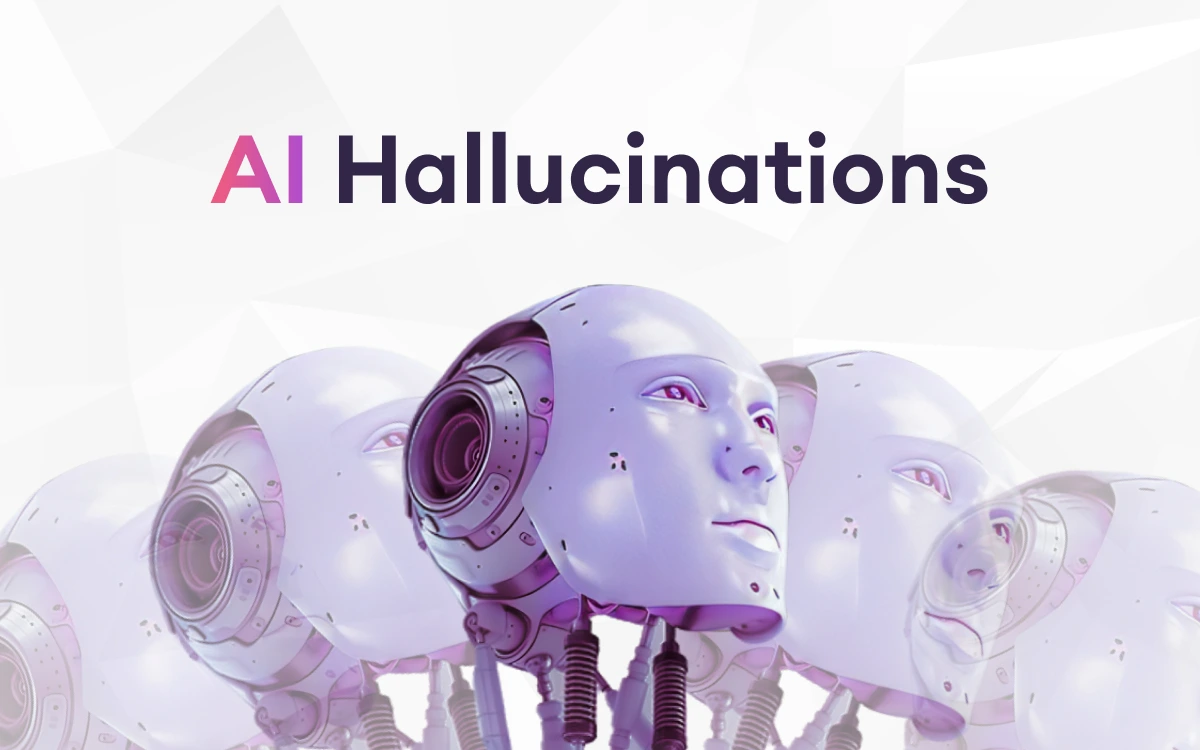AI Hallucinations occur
Recently, from large language model to generative AI capable of producing human-like text, generating images, and solving complex tasks, the rhythm of growth has been accelerated.
On the other hand, however, are several challenges, of which one serious problem being the AI hallucination.
AI hallucination refers to a situation in which generative AI systems, LLMs, or machine learning models provide either false, misleading, or entirely fabricated information.
Therefore, among the big effects of such hallucinations may be determining the veracity of content created through AI and carrying enormous risks once that information gets applied to sensitive areas, including in research, scientific research, or decision-making processes.
Understanding AI Hallucinations

AI Hallucination: The tendency of the model to generate text that is plausible in both sound and grammatical correctness but, in fact, is utterly fabricated or wrong.
This may occur within language models or generative AI whenever a model predicts the next word or phrase in sequence, given what it has seen in its data, but by which the output departs from underlying reality or fact.
For example, it could provide users with incorrect legal citations in AI-generated texts or even fabricate certain details about what the James Webb Space Telescope has observed in the solar system.
The inaccuracy of such content is a function of the model's logical fallacies coupled with misinterpretation of training data.
Most of these hallucinations result from poor training data, low-quality training data, or even a type of adversarial attack on the AI model.
If generative AI models have been trained on datasets that are inexact, biased, or incomplete, they are more prone to false or misleading outputs.
These faulty statements or misleading or false information, may have a great impact, particularly in the field of operation where correct information is vital.
Types of AI Hallucinations:

1. Fabricated Facts:
In this type of hallucination, completely fabricated facts are integrated into the generated content by AI models.
Imagine an AI text generator that comes up with a very plausible, but utterly false, version of some historical event or with the discovery of some scientific fact.
These hallucinations can come into legalese research, medical diagnosis, and even while discussing some real object, like the solar system, with serious consequences.
2. Contextual Misinterpretations:
This is when AI misunderstands the context of a query and provides factually incorrect answers that could make contextual sense.
An AI Chatbot might, for example, provide an alphabetically correct response to users, which sounds relevant but with slight factual inaccuracies since it missed the subtlety in what the user asked.
This happens quite a lot in large language models, especially where the system does not understand some complex idea or fine points of the language.
Causes of AI Hallucinations:

1. Inadequate, or Poor Quality Training Data:
Most the content produced by AI relies on the training data it receives. In most cases, biased, incomplete, or low-quality data engenders an increase in hallucinations.
Poor information over specific scientific research will have the model fabricate or misrepresent information on a query like the James Webb Space Telescope.
2. Model Overgeneralization:
Sometimes AI models generalize out of their training data into content areas they aren't very well-equipped to tackle.
That happens when the AI is faced with instances or data it has not seen before and will, hence, make a false statement.
For instance, an AI model might mislabel objects in computer vision or might mislead users about the most recent research if it over generalizes from limited or older information.
AI Model and Training Data templates

Everything is connected to the quality of the data that have been used for training. Large generative AI models are trained on enormous datasets containing all sorts of texts, images, or other types of data.
The problem comes in when this training data contains mistakes, biases, or omissions; this makes the AI model hallucinate.
For example,
when legally trained on data templates with incorrect or missing legal citations and outdated case law, the resulting AI may contain factual errors in generated texts and/or lead to flawed research or defective decision-making processes.
AI hallucinations also occur when the model has been taken beyond its limits. Conversely, when models in AI generate text on the basis of new information and complex queries beyond their training, they can state false statements and also give misleading outputs.
In many instances, this problem has posed serious challenges to making AI-generated content dependable.
It can be in cases where an AI chatbot may provide information to the user that is wrong regarding scientific research, such as incorrect facts about the first picture details of the James Webb Space Telescope, or incorrectly identifying objects in computer vision tasks that could be used to incorrectly identify the wrong objects in the solar system or real-life situations.
Impact of AI Hallucinations

But the risks of AI hallucinations go far beyond simple factual mistakes.
Where the conclusions the AI makes are most valuable, such as legal or scientific research or medical diagnoses, the consequences to individual lives or quality of life are substantial.
For instance, a chatbot may fabricate the legal precedents or misquote the relevant information in the legal citations to reach erroneous legal conclusions.
Such inaccuracies may affect decisions of cases, with serious implications of the possible outcomes of wrongful conviction or imperfectly devised strategies.
While this may be a parallel situation in scientific research, where an AI-composed output would hallucinate and set back progress by propounding as fact something which is not a reality, examples include details surrounding scientific discovery, such as incorrect information about the findings with the James Webb Space Telescope.
This could halt or set back future research or otherwise confuse the understanding of nature about the discovery.
Medical diagnoses or recommended courses of treatment may lead an AI system to hallucinate decisions for incorrect treatments that pose some risk to patient safety.
AI hallucinations in content creation can also mislead users regarding the veracity of that content.
For example, in cases of image creation or avatar generation, the process might result in completely fabricated features by hallucination.
While in these cases, the risks do not seem that critical as in healthcare or legal use cases, they still erode the trustworthiness of the AI technology.
How to Avoid AI Hallucinations

Various steps must be put in place to help avoid hallucinations in AI. First and foremost is improving the quality of the training data.
• Training with high-quality, diverse data:
Is key to overcoming the problem of AI hallucinations.
By providing more accurate, diverse, and plentiful datasets at the outset, it would be easier for an AI to produce factually correct information that is relevant to the question or prompt presented to it.
This may include data from many varied fields in order to create a strong overall knowledge base in most areas of interest.
There are fewer hallucinations when the training data contains newer and factually correct information.
For example, verified scientific research, updated legal texts, and current news can make a great deal of difference towards accuracy.
Regular Dataset Updates: Updating datasets will help keep out risks of inaccuracies in case an AI model needs to generate responses from outdated data.
• Fact-Checking & Knowledge Integration:
Real-time fact-checking can be integrated into the AI to avoid AI-generated false information.
Similarly, an AI can be engineered in such a way that it cross-checks its results with an external database for correctness.
Example: Perplexity AI, an internet search engine-powered AI tool, embeds real-time web searches in the process of fact-checking.
If it generates a response, it links to the most relevant, authoritative sources to confirm the information is correct, hence ensuring users receive fact-checked outputs.
Others include connecting the AI systems to specialized knowledge bases or trusted repositories like scientific journals, legal databases, or encyclopedias to enhance the factual integrity of generated content. Knowledge integration requires the following steps:
• Reinforcement Learning from Human Feedback Loops :
Human feedback helps in refining the outputs from AI and avoiding hallucination.
In RLHF, the model learns from interaction with human experts who correct the model's information that is in a misleading or inaccurate way.
It learns by getting grades on the output given, involving human judgments of correctness and relevance; the grades are used in enhancing behavior in future interactions.
In this respect, the model will be improved to being correct at all times by learning from mistakes made in the responses.
This would create a feedback loop, retraining the AI to avoid similar hallucinations in the future, especially in high-stakes domains like legal research, where correct citation and data are important.
• Retrieval-Augmented Generation Techniques:
RAG combines the power of generative AI models with retrieval systems to ensure the AI always has access to the most accurate up-to-date information when generating contents.
Instead, it pulls relevant data in from external sources in real-time to augment its generated response, rather than relying on its training data.
For instance, if a question on the James Webb Space Telescope is asked, RAG-based systems will identify the most recent research and reports on the telescope from reliable databases before synthesizing an answer.
This already limits hallucinations since this response is based on real-world, validated data.
It will make generative AI models less capable of producing misleading or false output by embedding retrieval mechanisms into the process, adding to the generative abilities actual real-time facts. This technique is particular and very effective in those fast-moving fields that deal with technology, science, or even legal research.
Solutions and Future Outlook
While AI hallucinations create significant issues, the AI community is vigorously working on ways to solve them.
It involves possible solutions with fine-tuning of an AI model for detecting hallucinations so that the contents are flagged before they show up in front of the users.
To achieve this, one could build models which are aware of their own limitations and communicate uncertainty with the users when they are not certain about the right answer.
The system could say, for instance, "I am not sure" or "I do not have enough information to answer this question correctly." Instead of giving a confident but false statement.
Independent developers are also weighing various options to eliminate AI systems as black boxes, where users would understand how and on what basis some particular model yields certain outputs.
With increased transparency, the possibility of spotting a potential hallucination becomes rather easy, and the content could be independently checked against reliable sources.
For instance, AI legal research or scientific discovery tools would suggest references to their own training datasets or sources based on which such output was held, which the user can check independently.
While the technology of AI is still evolving, this aspect of AI hallucinations needs much attention.
Newer models under development will reason better, use context, distinguish between correct and incorrect information, and further minimize the possibility of hallucinations.
In such a way, it enhances reliability in the content generated by AI for more domains.
Conclusion
AI hallucinations can be highly insecure in generative models, especially when resulting in fake or misleading information in legal research, scientific discovery, or decision-making processes.
The quality of training data, the level of complexity of tasks a model is doing, and adversarial attacks are factors to which AI hallucination occurrences are highly related.
Preventive measures against AI
Hallucinations include improving the quality of training data, embedding safeguards within models, periodic updates of new data in the AI system, and some degree of human oversight.
At present, considering the developments towards a more robust and transparent AI system, the future of AI technology looks promising.
While AI hallucinations remain a challenge, researched adversarial training, model transparency, and human-AI collaboration give cause for hope, thus minimizing risks due to hallucinated content.
If one is taking the right steps to deal with these challenges, AI will be able to play its transformative role in almost every aspect of life while mitigating harm caused due to hallucinations.